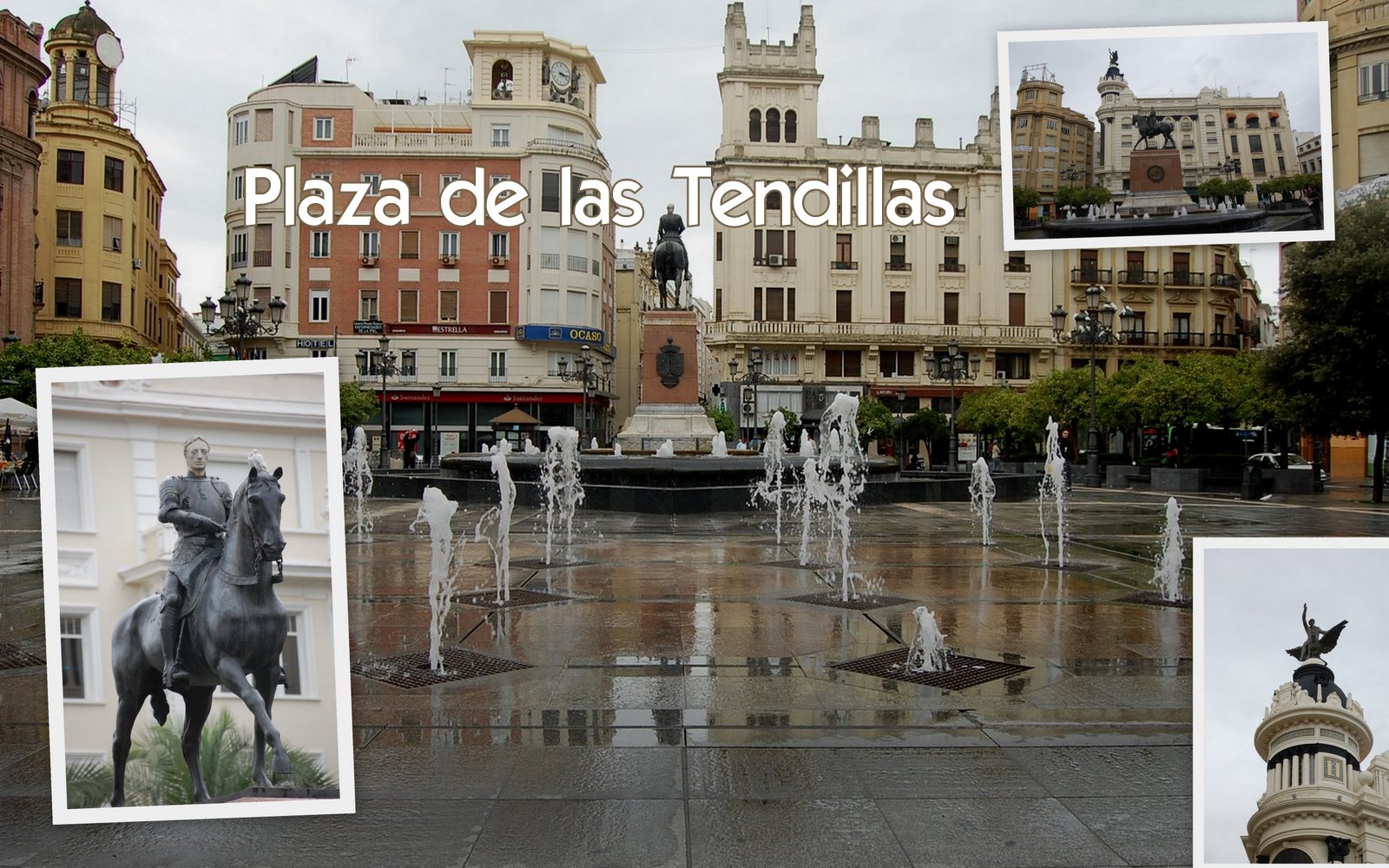
Above is a clumsy wraparound picture suggesting the sweep of this broad plaza. It’s named after the small boutiques ("tiendas") which once surrounded the square and flourished in the 17th and 18th centuries. Upscale modern and sometimes even monumental buildings have replaced these.
Lacking a Times Square, this is where Córdobans gather for the New Years’ Eve countdown under the 1961 vintage clock at center which tolls for thee with Flamenco soleá music. (In soleá, one guitar plays in the key of E minor or sometimes less fretfully in A minor.) Of course, the clock plays a recording of internationally acclaimed Flamenco artist – and Cordoban native -- Juan Serrano -- who is somewhat forgotten in Spain but more famous worldwide. He founded the International Flamenco Society of Michigan. (But he still may not be a name in your household. If you can't afford a ticket to Córdoba, rent Woody Allen's 2008 movie Vicky Cristina Barcelona and listen.)
As the town’s dominant square, Plaza de las Tendillas has not one but two fountains to make its marble mirror its monuments. If that weren't enough, we got rained on as well. The pool around the statue was created in 1970 by perhaps the town’s most aptly named architect: Carlos Font. The 16 jets springing somewhat spontaneously up through the pavement were added in 1999.
Ironically work was temporarily halted during that construction when workers dug up what they thought was an ancient cistern stretching back to to the Moorish Umayyad dynasty. It turned out to be old plumbing from a hotel razed in 1923.
Each building lining the square seems to have its own character such as the one pictured above with two spectacular Baroque towers rising atop the traditional Andalusian gallery on the top floor. All this, of course, is marred by a plethora of TV antennas scratching the clouds.
This space originally housed the Order of Calatrava in the 14th century. This was one of those groups of fighting monks who helped the Crown take back Iberia from the Moors. Around the turn of the 20th century, the plaza began to assume its present shape due to architect Patricio de Bolomburu who redid many of Cordoba’s squares.
Here's a tale of two statues. At rear is the 1926 Building of the
Union and the Phoenix, the work of architect Benjamin Gutierrez Prieto,
capped by a monumental sculpture. At left (below) is the
focus of the square: Córdoba native Mateo Inurria’s 1915
statue of El Gran Capitán who died exactly 4 centuries earlier.
The Capitan has obviously been to a tanning parlor with a bag on his
head as his body and horse are bronzed but his head is white marble,
perhaps to match the pigeon. (In fact, the head was modeled after that
of a friend of the sculptor, the bullfighter Largatijo.)
Gonzalo Fernández de Córdoba was called El Gran Capitán after making Spain the world’s greatest military power. As a second child, he could not inherit the family estate, and he wasn’t much interested in being a priest – therefore a warrior in the king’s service was his best path upward. He came of age in the 10-year war against Granada including beating back the Moors in front of Queen Isabel who became a lifelong patron (her life, not his; after Isabel died, King Ferdinand greatly praised the old warrior and then forced him into retirement.)
After Granada, El Gran Capitán took the battle to Italy with great success. He was a military genius able to blend into an irresistible force the infantry, cavalry, and the newly emerging offensive artillery. He defined warfare as wiping out the opposing army, not just capturing territory. For 3 centuries, his legacy was unequalled until that upstart Napoleon came along.Above right and below is the square's second statue atop the Building of the Union and the Phoenix. What is this tall statue that looks down on Spain's greatest military leader? This is not San Rafael but a very loosely toga clad gentleman riding an imperial eagle. Most likely it's some cloudy sculptural reference to the legend of the Phoenix since the building is named after its owners: The Union and Phoenix, a major Spanish insurer. Perhaps they'll convert it to the healer San Rafael if Obama's universal health insurance gets passed. Got fish?
We came to see its past, but above 's a perfectly gratuitous shot of Córdoba's future. In what was once Europe's most sophisticated heterogeneous town, the tykes all appear cut from the same cloth -- but still pretty cute. This is a real town where real people raise real kids -- yet it does a nice job of taking care of tourists with good signage, parking, restrooms, and maps. In short, a town much more than its great Mosque.
Thanks for visiting Córdoba with us,
even though we may have been a millennium too late to see Europe's
greatest city. Check out our other travel pictures by clicking here. If you haven't visited our Córdoba mosque pictures yet, please click here.
|
Please join us in the following slide show to give Córdoba the viewing it deserves by clicking here. |
|
Geek and Legal StuffPlease allow JavaScript to enable word definitions. This page has been tested in Internet Explorer 8.0, Firefox 3.0, and Google Chrome 1.0. Created on June 15, 2009 |
 |